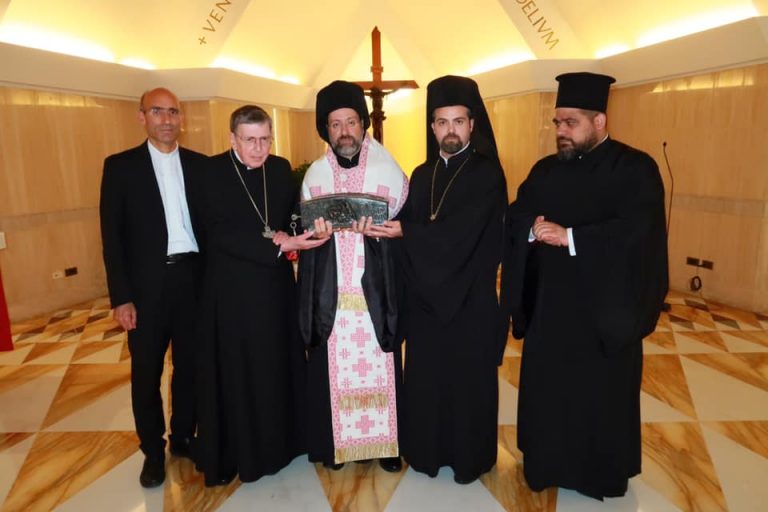
The delegation of the Ecumenical Patriarchate, which participated in the celebration of the throne feast of the Church of Rome on 29 June 2019, received from Pope Francis an unexpected and valuable gift: a reliquary with the holy relics of Saint Peter the Apostle, which were kept in the private chapel of the Pope at the Apostolic Palace in the Vatican. These are nine fragments of Saint Peter’s bones, which, after important archaeological excavations, have been confirmed to be authentic. At the request of Pope Paul VI in 1968, these fragments have been separated from the rest of the relics and placed in a bronze reliquary with the inscription: “Of the bones found in the Vatican Basilica belonging to the holy Apostle Peter”. These relics were exhibited in the Basilica of Saint Peter in the Vatican only once, on 24 November, 2013, on the occasion of the closing of the Holy Year of Faith. The rest of the relics of the Apostle are kept under the main altar of Saint Peter’s Basilica in the Vatican.
Archbishop Job of Telmessos, Co-Chairman of the Mixed International Commission for the Theological Dialogue between the Roman Catholic Church and the Orthodox Church, who headed the official delegation of the Ecumenical Patriarchate, has reported about this event. On 29 June, 2019, after the Papal Mass in the Basilica of St. Peter, His Holiness Pope Francis invited him to descend to the tomb of St. Peter under the main altar. They prayed together and the Pope then told him that he had “a gift for the Church of Constantinople”, not indicating what he intended, and invited him to accompany him to the Apostolic Palace. In the private chapel of the popes, he took the reliquary into his hands and handed it to Archbishop Job.
“When we entered the chapel,” said Archbishop Job, “the Pope Francis explained to me that Pope Paul VI wanted to keep a part of the relics of St. Peter from the Vatican Basilica in his private chapel. Further, Pope Francis told him that during the prayer the previous evening he had this thought: “I no longer live in the Apostolic Palace, I never use this chapel, I never serve the Holy Mass here, and we have St. Peter’s relics in the basilica itself, so it will be better if they will be kept in Constantinople. This is my gift to the Church of Constantinople. Please take this reliquary and give it to my brother Patriarch Bartholomew. This gift is not from me, it is a gift from God.” Archbishop Job admitted that this decision of Pope Francis was a surprise to everyone: “This is an extraordinary and unexpected event that we did not expect. The relics of the Holy Apostle Peter were always kept in Rome where they were the purpose of pilgrimages. The Orthodox Church has never asked for them since they never belonged to the Church of Constantinople. This time, we do not speak of a return of relics to their original place. This time, the relics are being presented as a gift. This prophetic gesture is another huge step on the path to concrete unity,” stressed Archbishop Job of Telmessos.
Archbishop Job immediately reported the event to His All-Holiness Ecumenical Patriarch Bartholomew who expressed his immense joy. The transfer of the relics of the Holy Apostle Peter from Rome to Constantinople were accompanied by Monsignor Andrea Palmieri, deputy secretary of the Pontifical Council for the promotion of Christian unity. They were exposed to the veneration of the faithful during the solemn Divine Liturgy presided by His All-Holiness Ecumenical Patriarch Bartholomew on the occasion of the feast of the Holy Twelve Apostles, on 30 June, 2019, celebrated in the Church of the Holy Apostles in Feriköy, in the neighborhood of Şişli in Istanbul. After that, the reliquary will be kept at the Ecumenical Patriarchate.
The first stage of archaeological excavations under the main altar of St. Peter’s basilica took place on the initiative of Pope Pius XII from 1939 to 1949. As a result, the place of burial of the Holy Apostle Peter was found, but his remains were not yet found. In 1952, scientists pursued a study led by Margherita Guardacci. The object of study was the wall, next to the monument built over the grave of St. Peter in the 2nd century. It was covered with many ancient graffiti with Christian symbols and mentioned the names of Jesus, Mary, Peter. One of the inscriptions, about 160 years old, in Greek, reported: “Petros eni”: “Peter is here”, probably pointing to the location of the relics. A small niche was found nearby where bones were found. The scientific analysis showed that the remains belong to a man who lived in the beginning of the first century, was of a solid body constitution and died at an advanced age. On them were found particles of earth, identical to that which is located under the gravestone monument, as well as fragments of purple fabric with golden thread — a testimony of the particular respect for the buried person. There were no feet found. This detail is very important, since St. Peter has been crucified with his head down with his feet cut off. The results of the research have allowed to state that the remains found under the basilica were those of St. Peter. This was officially declared by Pope Paul VI on 26 June, 1968. When scientists completed their work, most of the relics were left in the place where they were stored for centuries, in the small niche in the wall under the main altar of the basilica. Nine fragments where taken by Pope Paul VI who ordered to placed them in a bronze reliquary and stored in the papal apartments of the Apostolic Palace. This is precisely this reliquary that was given by Pope Francis to the Church of Constantinople.